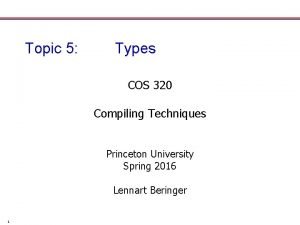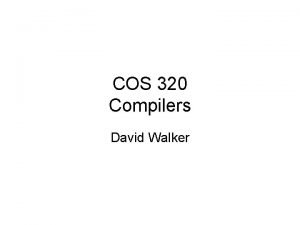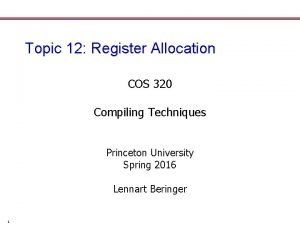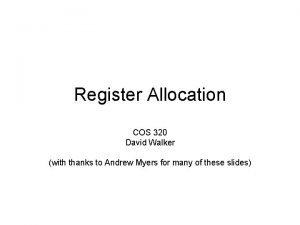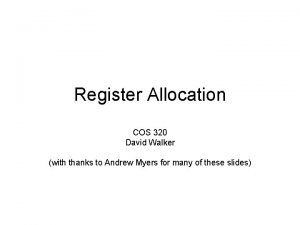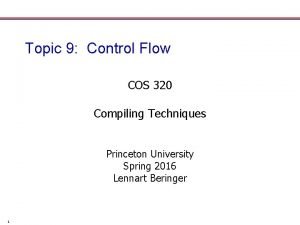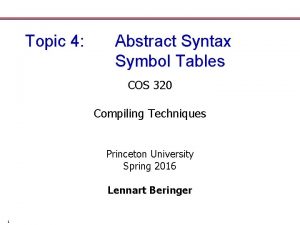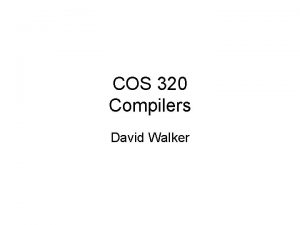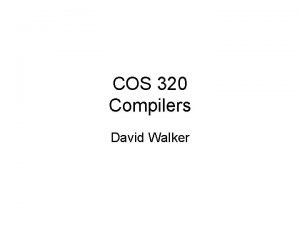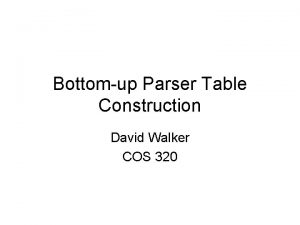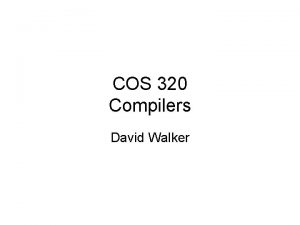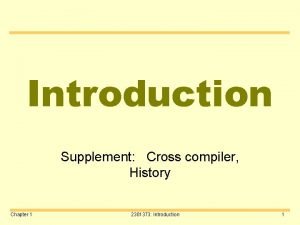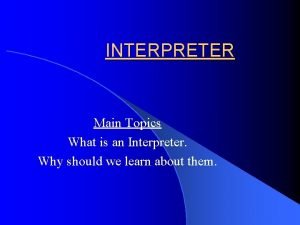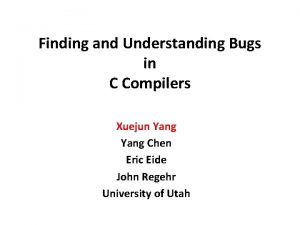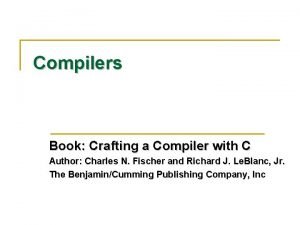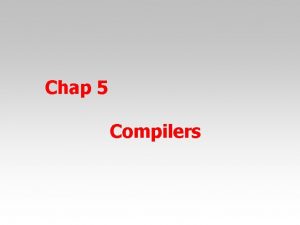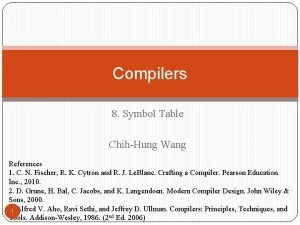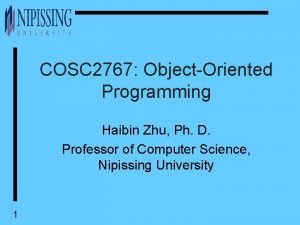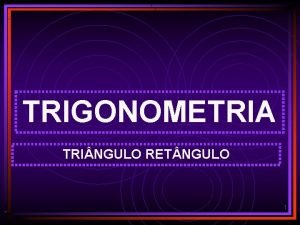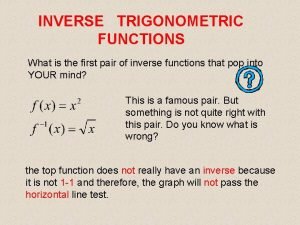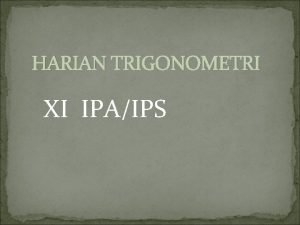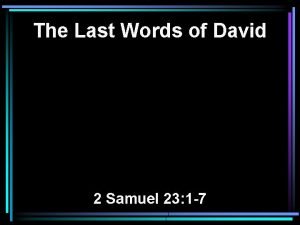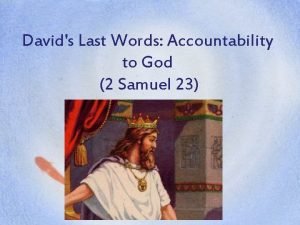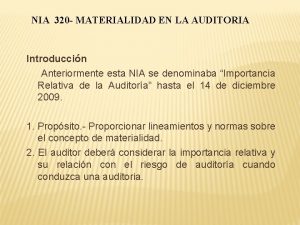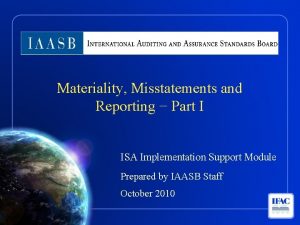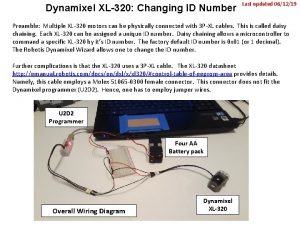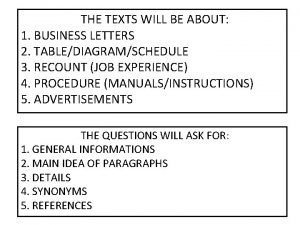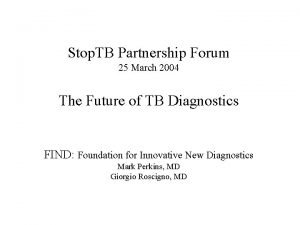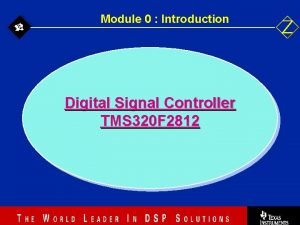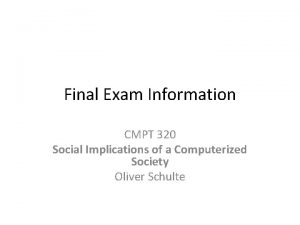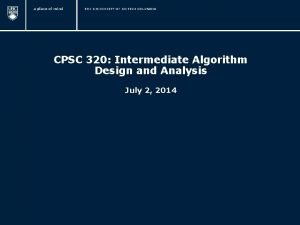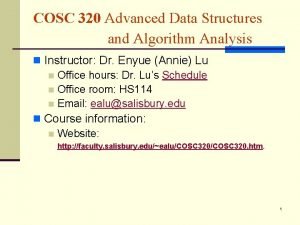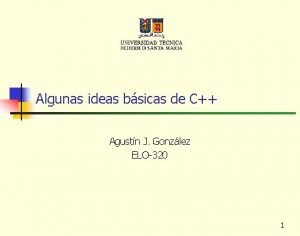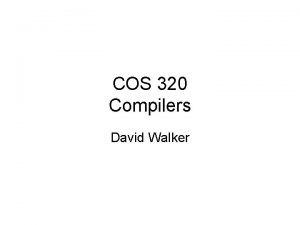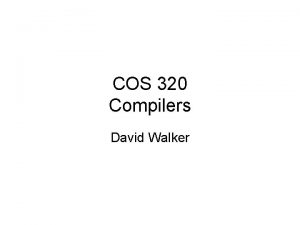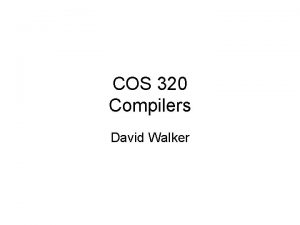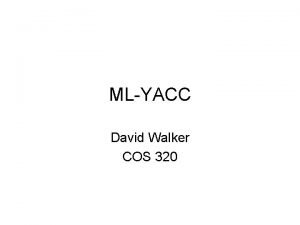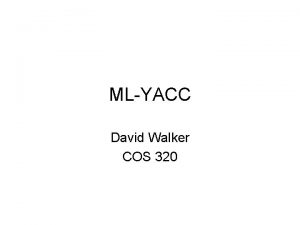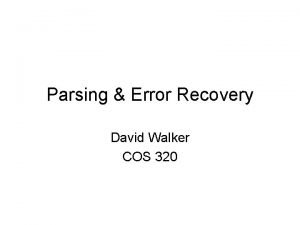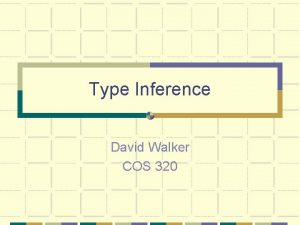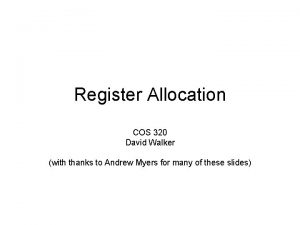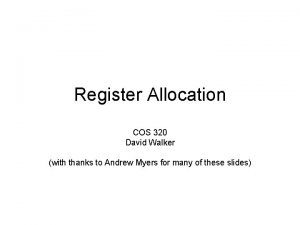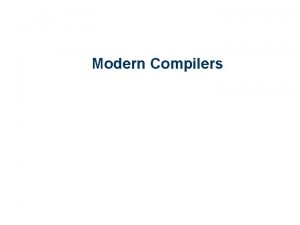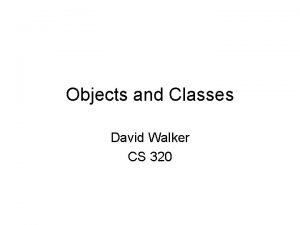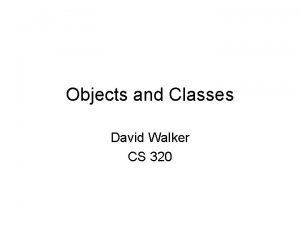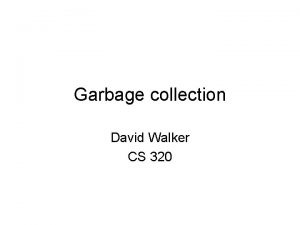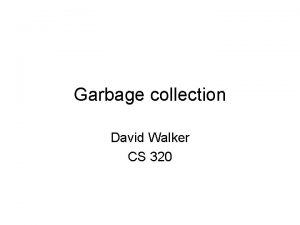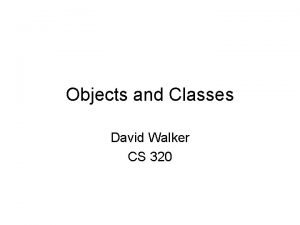COS 320 Compilers David Walker last time context


























































- Slides: 58

COS 320 Compilers David Walker

last time • context free grammars (Appel 3. 1) – terminals, non-terminals, rules – derivations & parse trees – ambiguous grammars • recursive descent parsers (Appel 3. 2) – parse LL(k) grammars – easy to write as ML programs – algorithms for automatic construction from a CFG

non-terminals: S, E, L terminals: NUM, IF, THEN, ELSE, BEGIN, END, PRINT, ; , = rules: 1. S : : = IF E THEN S ELSE S 4. L : : = END 2. | BEGIN S L 5. |; SL 3. | PRINT E 6. E : : = NUM datatype token = NUM | IF | THEN | ELSE | BEGIN | END | PRINT | SEMI | EQ val tok = ref (get. Token ()) fun advance () = tok : = get. Token () fun eat t = if (! tok = t) then advance () else error () fun S () = case !tok of IF => eat IF; E (); eat THEN; S (); eat ELSE; S () | BEGIN => eat BEGIN; S (); L () | PRINT => eat PRINT; E () and L () = case !tok of END => eat END | SEMI => eat SEMI; S (); L () and E () = eat NUM; eat EQ; eat NUM

Constructing RD Parsers • To construct an RD parser, we need to know what rule to apply when – we have seen a non terminal X – we see the next terminal a in input • We apply rule X : : = s when – a is the first symbol that can be generated by string s, OR – s reduces to the empty string (is nullable) and a is the first symbol in any string that can follow X

Computing Nullable Sets • Non-terminal X is Nullable only if the following constraints are satisfied (computed using iterative analysis) – base case: • if (X : = ) then X is Nullable – inductive case: • if (X : = ABC. . . ) and A, B, C, . . . are all Nullable then X is Nullable

Computing First Sets • First(X) is computed iteratively – base case: • if T is a terminal symbol then First (T) = {T} – inductive case: • if X is a non-terminal and (X: = ABC. . . ) then – First (X) = First (X) U First (ABC. . . ) where First(ABC. . . ) = F 1 U F 2 U F 3 U. . . and » F 1 = First (A) » F 2 = First (B), if A is Nullable » F 3 = First (C), if A is Nullable & B is Nullable » . . .

Computing Follow Sets • Follow(X) is computed iteratively – base case: • initially, we assume nothing in particular follows X – (Follow (X) is initially { }) – inductive case: • if (Y : = s 1 X s 2) for any strings s 1, s 2 then – Follow (X) = First (s 2) U Follow (X) • if (Y : = s 1 X s 2) for any strings s 1, s 2 then – Follow (X) = Follow(Y) U Follow (X), if s 2 is Nullable

building a predictive parser Z : : = X Y Z Z : : = d Y : : = c Y : : = nullable Z Y X X : : = a X : : = b Y e first follow

building a predictive parser Z : : = X Y Z Z : : = d Y : : = c Y : : = nullable Z no Y yes X no base case X : : = a X : : = b Y e first follow

building a predictive parser Z : : = X Y Z Z : : = d Y : : = c Y : : = nullable Z no Y yes X no X : : = a X : : = b Y e first follow after one round of induction, we realize we have reached a fixed point

building a predictive parser Z : : = X Y Z Z : : = d Y : : = c Y : : = X : : = a X : : = b Y e nullable first Z no d Y yes c X no a, b base case follow

building a predictive parser Z : : = X Y Z Z : : = d Y : : = c Y : : = X : : = a X : : = b Y e nullable first Z no d, a, b Y yes c X no a, b after one round of induction, no fixed point follow

building a predictive parser Z : : = X Y Z Z : : = d Y : : = c Y : : = X : : = a X : : = b Y e nullable first Z no d, a, b Y yes c X no a, b follow after two rounds of induction, no more changes ==> fixed point

building a predictive parser Z : : = X Y Z Z : : = d Y : : = c Y : : = X : : = a X : : = b Y e nullable first follow Z no d, a, b {} Y yes c {} X no a, b {} base case

building a predictive parser Z : : = X Y Z Z : : = d Y : : = c Y : : = X : : = a X : : = b Y e nullable first follow Z no d, a, b {} Y yes c e, d, a, b X no a, b c, d, a, b after one round of induction, no fixed point

building a predictive parser Z : : = X Y Z Z : : = d Y : : = c Y : : = X : : = a X : : = b Y e nullable first follow Z no d, a, b {} Y yes c e, d, a, b X no a, b c, d, a, b after two rounds of induction, fixed point (but notice, computing Follow(X) before Follow (Y) would have required 3 rd round)

Grammar: Z : : = X Y Z Z : : = d Computed Sets: Y : : = c Y : : = X : : = a X : : = b Y e nullable first follow Z no d, a, b {} Y yes c e, d, a, b X no a, b c, d, a, b • if T First(s) then enter (X : : = s) in row X, col T • if s is Nullable and T Follow(X) enter (X : : = s) in row X, col T Build parsing table where row X, col T tells parser which clause to execute in function X with next-token T: a Z Y X b c d e

Grammar: Z : : = X Y Z Z : : = d Computed Sets: Y : : = c Y : : = X : : = a X : : = b Y e nullable first follow Z no d, a, b {} Y yes c e, d, a, b X no a, b c, e, d, a, b • if T First(s) then enter (X : : = s) in row X, col T • if s is Nullable and T Follow(X) enter (X : : = s) in row X, col T Build parsing table where row X, col T tells parser which clause to execute in function X with next-token T: Z Y X a b Z : : = XYZ c d e

Grammar: Z : : = X Y Z Z : : = d Computed Sets: Y : : = c Y : : = X : : = a X : : = b Y e nullable first follow Z no d, a, b {} Y yes c e, d, a, b X no a, b c, e, d, a, b • if T First(s) then enter (X : : = s) in row X, col T • if s is Nullable and T Follow(X) enter (X : : = s) in row X, col T Build parsing table where row X, col T tells parser which clause to execute in function X with next-token T: Z Y X a b Z : : = XYZ c d Z : : = d e

Grammar: Z : : = X Y Z Z : : = d Computed Sets: Y : : = c Y : : = X : : = a X : : = b Y e nullable first follow Z no d, a, b {} Y yes c e, d, a, b X no a, b c, e, d, a, b • if T First(s) then enter (X : : = s) in row X, col T • if s is Nullable and T Follow(X) enter (X : : = s) in row X, col T Build parsing table where row X, col T tells parser which clause to execute in function X with next-token T: Z Y X a b Z : : = XYZ c d Z : : = d Y : : = c e

Grammar: Z : : = X Y Z Z : : = d Computed Sets: Y : : = c Y : : = X : : = a X : : = b Y e nullable first follow Z no d, a, b {} Y yes c e, d, a, b X no a, b c, e, d, a, b • if T First(s) then enter (X : : = s) in row X, col T • if s is Nullable and T Follow(X) enter (X : : = s) in row X, col T Build parsing table where row X, col T tells parser which clause to execute in function X with next-token T: a b Z Z : : = XYZ Y Y : : = X c d e Z : : = d Y : : = c Y : : =

Grammar: Z : : = X Y Z Z : : = d Computed Sets: Y : : = c Y : : = X : : = a X : : = b Y e nullable first follow Z no d, a, b {} Y yes c e, d, a, b X no a, b c, e, d, a, b • if T First(s) then enter (X : : = s) in row X, col T • if s is Nullable and T Follow(X) enter (X : : = s) in row X, col T Build parsing table where row X, col T tells parser which clause to execute in function X with next-token T: a b Z Z : : = XYZ Y Y : : = X X : : = a X : : = b Ye c d e Z : : = d Y : : = c Y : : =

Grammar: Z : : = X Y Z Z : : = d Computed Sets: Y : : = c Y : : = X : : = a X : : = b Y e nullable first follow Z no d, a, b {} Y yes c e, d, a, b X no a, b c, e, d, a, b d e What are the blanks? a b Z Z : : = XYZ Y Y : : = X X : : = a X : : = b Ye c Z : : = d Y : : = c Y : : =

Grammar: Z : : = X Y Z Z : : = d Computed Sets: Y : : = c Y : : = X : : = a X : : = b Y e nullable first follow Z no d, a, b {} Y yes c e, d, a, b X no a, b c, e, d, a, b d e What are the blanks? --> syntax errors a b Z Z : : = XYZ Y Y : : = X X : : = a X : : = b Ye c Z : : = d Y : : = c Y : : =

Grammar: Z : : = X Y Z Z : : = d Computed Sets: Y : : = c Y : : = X : : = a X : : = b Y e nullable first follow Z no d, a, b {} Y yes c e, d, a, b X no a, b c, e, d, a, b Is it possible to put 2 grammar rules in the same box? a b Z Z : : = XYZ Y Y : : = X X : : = a X : : = b Ye c d e Z : : = d Y : : = c Y : : =

Grammar: Z : : = X Y Z Z : : = d e Computed Sets: Y : : = c Y : : = X : : = a X : : = b Y e nullable first follow Z no d, a, b {} Y yes c e, d, a, b X no a, b c, e, d, a, b Is it possible to put 2 grammar rules in the same box? a b Z Z : : = XYZ Y Y : : = X X : : = a X : : = b Y e c d e Z : : = d e Y : : = c Y : : =

predictive parsing tables • if a predictive parsing table constructed this way contains no duplicate entries, the grammar is called LL(1) – Left-to-right parse, Left-most derivation, 1 symbol lookahead • if not, of the grammar is not LL(1) • in LL(k) parsing table, columns include every klength sequence of terminals: aa ab ba bb ac ca . . .

another trick • Previously, we saw that grammars with left -recursion were problematic, but could be transformed into LL(1) in some cases • the example non-LL(1) grammar we just saw: Z : : = X Y Z Z : : = d e • how do we fix it? Y : : = c Y : : = X : : = a X : : = b Y e

another trick • Previously, we saw that grammars with left -recursion were problematic, but could be transformed into LL(1) in some cases • the example non-LL(1) grammar we just saw: Z : : = X Y Z Z : : = d e Y : : = c Y : : = X : : = a X : : = b Y e • solution here is left-factoring: Z : : = X Y Z Z : : = d W W : : = e Y : : = c Y : : = X : : = a X : : = b Y e

summary of RD parsing • CFGs are good at specifying programming language structure • parsing general CFGs is expensive so we define parsers for simpler classes of CFG – LL(k), LR(k) • we can build a recursive descent parser for LL(k) grammars by: – – computing nullable, first and follow sets constructing a parse table from the sets checking for duplicate entries, which indicates failure creating an ML program from the parse table • if parser construction fails we can – rewrite the grammar (left factoring, eliminating left recursion) and try again – try to build a parser using some other method

summary of RD parsing • CFGs are good at specifying programming language structure • parsing general CFGs is expensive so we define parsers for simpler classes of CFG – LL(k), LR(k) • we can build a recursive descent parser for LL(k) grammars by: – – computing nullable, first and follow sets constructing a parse table from the sets checking for duplicate entries, which indicates failure creating an ML program from the parse table • if parser construction fails we can – rewrite the grammar (left factoring, eliminating left recursion) and try again – try to build a parser using some other method. . . such as using a bottomup parsing technique

Bottom-up (Shift-Reduce) Parsing

shift-reduce parsing • shift-reduce parsing – aka: bottom-up parsing – aka: LR(k) Left-to-right parse, Rightmost derivation, k-token lookahead • more powerful than LL(k) parsers • LALR variant: – the basis for parsers for most modern programming languages – implemented in tools such as ML-Yacc

shift-reduce parsing example Parsing Table Grammar: A : : = S EOF L : : = L ; S L : : = S S : : = ( L ) S : : = id = num

shift-reduce parsing example Parsing Table Grammar: A : : = S EOF L : : = L ; S L : : = S S : : = ( L ) S : : = id = num yet to read Input from lexer: ( id = num ; id = num ) EOF State of parse so far:

shift-reduce parsing example Parsing Table Grammar: A : : = S EOF L : : = L ; S L : : = S S : : = ( L ) S : : = id = num yet to read Input from lexer: ( id = num ; id = num ) EOF State of parse so far: ( SHIFT

shift-reduce parsing example Parsing Table Grammar: A : : = S EOF L : : = L ; S L : : = S S : : = ( L ) S : : = id = num yet to read Input from lexer: ( id = num ; id = num ) EOF State of parse so far: ( id SHIFT

shift-reduce parsing example Parsing Table Grammar: A : : = S EOF L : : = L ; S L : : = S S : : = ( L ) S : : = id = num yet to read Input from lexer: ( id = num ; id = num ) EOF State of parse so far: ( id = SHIFT

shift-reduce parsing example Parsing Table Grammar: A : : = S EOF L : : = L ; S L : : = S S : : = ( L ) S : : = id = num yet to read Input from lexer: ( id = num ; id = num ) EOF State of parse so far: ( id = num SHIFT

shift-reduce parsing example Parsing Table Grammar: A : : = S EOF L : : = L ; S L : : = S S : : = ( L ) S : : = id = num yet to read Input from lexer: ( id = num ; id = num ) EOF State of parse so far: ( S REDUCE S : : = id = num

shift-reduce parsing example Parsing Table Grammar: A : : = S EOF L : : = L ; S L : : = S S : : = ( L ) S : : = id = num yet to read Input from lexer: ( id = num ; id = num ) EOF State of parse so far: ( L REDUCE L : : = S

shift-reduce parsing example Parsing Table Grammar: A : : = S EOF L : : = L ; S L : : = S S : : = ( L ) S : : = id = num yet to read Input from lexer: ( id = num ; id = num ) EOF State of parse so far: ( L ; SHIFT

shift-reduce parsing example Parsing Table Grammar: A : : = S EOF L : : = L ; S L : : = S S : : = ( L ) S : : = id = num yet to read Input from lexer: ( id = num ; id = num ) EOF State of parse so far: ( L ; id = num SHIFT

shift-reduce parsing example Parsing Table Grammar: A : : = S EOF L : : = L ; S L : : = S S : : = ( L ) S : : = id = num yet to read Input from lexer: ( id = num ; id = num ) EOF State of parse so far: ( L ; S REDUCE S : : = id = num

shift-reduce parsing example Parsing Table Grammar: A : : = S EOF L : : = L ; S L : : = S S : : = ( L ) S : : = id = num yet to read Input from lexer: ( id = num ; id = num ) EOF State of parse so far: ( L REDUCE S : : = L ; S

shift-reduce parsing example Parsing Table Grammar: A : : = S EOF L : : = L ; S L : : = S S : : = ( L ) S : : = id = num yet to read Input from lexer: ( id = num ; id = num ) EOF State of parse so far: ( L ) SHIFT

shift-reduce parsing example Parsing Table Grammar: A : : = S EOF L : : = L ; S L : : = S S : : = ( L ) S : : = id = num yet to read Input from lexer: ( id = num ; id = num ) EOF State of parse so far: S REDUCE S : : = ( L )

shift-reduce parsing example Parsing Table Grammar: A : : = S EOF L : : = L ; S L : : = S S : : = ( L ) S : : = id = num Input from lexer: ( id = num ; id = num ) EOF State of parse so far: A SHIFT REDUCE A : : = S EOF ACCEPT

shift-reduce parsing example Parsing Table Grammar: A : : = S EOF L : : = L ; S L : : = S S : : = ( L ) S : : = id = num Input from lexer: ( id = num ; id = num ) EOF State of parse so far: A A successful parse! Is this grammar LL(1)?

Shift-reduce algorithm • Parser keeps track of – position in current input (what input to read next) – a stack of terminal & non-terminal symbols representing the “parse so far” • Based on next input symbol & stack, parser table indicates – shift: push next input on to top of stack – reduce R: • top of stack should match RHS of rule • replace top of stack with LHS of rule – error – accept (we shift EOF & can reduce what remains on stack to start symbol)

Shift-reduce algorithm (a detail) • The parser summarizes the current “parse state” using an integer – the integer is actually a state in a finite automaton – the current parse state can be computed by running the automaton over the current parse stack • Revised algorithm: Based on next input symbol & the parse state (as opposed to the entire stack), parser table indicates – shift s: • push next input on to top of stack and move automaton into state s – reduce R & goto s: • top of stack should match RHS of rule • replace top of stack with LHS of rule • move automaton into state s – error – accept

shift-reduce parsing Grammar: ? ? Input from lexer: ? ? ? ? EOF State of parse so far: ? ? Like LL parsing, shift-reduce parsing does not always work. What sort of grammar rules make shift-reduce parsing impossible?

shift-reduce parsing Grammar: ? ? Input from lexer: ? ? ? ? EOF State of parse so far: ? ? Like LL parsing, shift-reduce parsing does not always work. • Shift-Reduce errors: can’t decide whether to Shift or Reduce • Reduce-Reduce errors: can’t decide whether to Reduce by R 1 or R 2

shift-reduce errors Grammar: A : : = S EOF S : : = S + S S : : = S * S S : : = id Input from lexer: ? ? ? ? EOF State of parse so far: ? ?

shift-reduce errors Grammar: A : : = S EOF S : : = S + S S : : = S * S S : : = id Input from lexer: id + id * id EOF State of parse so far: S + S • reduce by rule (S : : = S + S) or • shift the * ? ? ? notice, this is an ambiguous grammar – we are always going to need some mechanism for resolving the outstanding ambiguity before parsing

shift-reduce errors Grammar: A : : = S id EOF S : : = E ; E : : = E ; E E : : = id Input from lexer: id ; id EOF some unambiguous grammars can’t be parsed by LR(1) parsers either id ; id EOF State of parse so far: E ; • reduce by rule (S : : = E ; ) or • shift the id input might be this, making shifting correct

reduce-reduce errors Grammar: A : : = S EOF S : : = ( E ) S : : = E Input from lexer: ( id ) EOF State of parse so far: ( E ) • reduce by rule ( S : : = ( E ) ) or • reduce by rule ( E : : = ( E ) ) E : : = ( E ) E : : = E + E E : : = id

Summary • Top-down Parsing – simple to understand implement – you can code it yourself using nullable, first, follow sets – excellent for quick & dirty parsing jobs • Bottom-up Parsing – more complex: uses stack & table – more powerful – Bonus: tools do the work for you ==> ML-Yacc • but you need to understand how shift-reduce & reduce errors can arise
 Cos 320
Cos 320 Cos 320
Cos 320 Cos 320
Cos 320 Cos 320°
Cos 320° Cos 320
Cos 320 Cos 320
Cos 320 Cos320
Cos320 Cos 320
Cos 320 Cos 320
Cos 320 Cos 320
Cos 320 Cos 320°
Cos 320° Cos320
Cos320 Cs 421 programming languages and compilers
Cs 421 programming languages and compilers Binarymove c++
Binarymove c++ Cousins of compiler
Cousins of compiler What is an interpreter
What is an interpreter Finding and understanding bugs in c compilers
Finding and understanding bugs in c compilers Crafting a compiler
Crafting a compiler Machine dependent compiler features
Machine dependent compiler features Explain front end and back end of compiler in detail
Explain front end and back end of compiler in detail Lex leblanc
Lex leblanc Advantages and disadvantages of compiler and interpreter
Advantages and disadvantages of compiler and interpreter Cs 421 uiuc
Cs 421 uiuc Nonagist
Nonagist High context vs low context culture ppt
High context vs low context culture ppt Pragmatics examples
Pragmatics examples Komunikasi verbal adalah
Komunikasi verbal adalah The flowers short story
The flowers short story Diketahui cos a = 0,6 dan a sudut lancip nilai sin 2 adalah
Diketahui cos a = 0,6 dan a sudut lancip nilai sin 2 adalah Cos c -cos d
Cos c -cos d Sederhanakan 2 cos 15° sin 30° + 2 sin 25° sin 15°
Sederhanakan 2 cos 15° sin 30° + 2 sin 25° sin 15° Sen a cos b sen b cos a
Sen a cos b sen b cos a Struttura della fabula
Struttura della fabula Struttura del testo narrativo
Struttura del testo narrativo Composition of inverse trig functions
Composition of inverse trig functions 6 sin 112,5 sin 22,5
6 sin 112,5 sin 22,5 Tentukan nilai trigonometri sin 315°
Tentukan nilai trigonometri sin 315° Start time end time and elapsed time
Start time end time and elapsed time 2 samuel 23:1-2
2 samuel 23:1-2 The last words of david
The last words of david Pms 320 navy
Pms 320 navy Notifier 320 manual
Notifier 320 manual Introduccion de la nia 320
Introduccion de la nia 320 Materiality isa
Materiality isa Miaa-320
Miaa-320 Dynamixel wizard download
Dynamixel wizard download The new futura 320 laser printer
The new futura 320 laser printer The new futura 320 laser printer
The new futura 320 laser printer Cyranose 320 ebay
Cyranose 320 ebay Simplify radical 54
Simplify radical 54 How many sig figs in 320
How many sig figs in 320 Tms 320
Tms 320 Orea form 100
Orea form 100 Cmpt 320
Cmpt 320 Aae 320
Aae 320 Cpsc 320
Cpsc 320 Cosc 320
Cosc 320 Service process matrix
Service process matrix Ytmp 320
Ytmp 320
